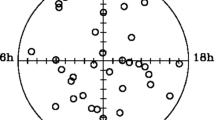Abstract
The primary purpose of the International very long baseline interferometry (VLBI) Service for Geodesy and Astrometry Intensive sessions is the rapid estimation of UT1-TAI. Improving the robustness and the precision of the UT1 estimates from the Intensives is an important goal. The INT01 series, which usually uses the Kokee–Wettzell baseline and runs on weekdays, is the most regular IVS Intensive series. The United States Naval Observatory which schedules these sessions traditionally used a small list of strong sources. In 2009, the authors requested and received the use of nine IVS R&D sessions for the evaluation of a new strategy which draws on all sources mutually visible on the Kokee–Wettzell baseline. Analysis of these sessions was sufficiently promising that in July 2010, USNO began to alternate the use of the original and the new strategy in scheduling the INT01 sessions to assess the operational effectiveness of the proposed strategy. In this paper, we summarize our analysis of the R&D sessions, and we also analyze 2 years of operational INT01 sessions. Considered in toto, the new strategy performs as well as, or better than, the original strategy in terms of several measures of robustness and precision. Furthermore, the RMS difference of the UT1 estimates from the 1 h operational INTO1 sessions and concurrently run 24 h VLBI sessions is 21.0 \(\upmu \)s, compared to 30.7 \(\upmu \)s using the standard strategy, indicating that the new strategy is, on average, 30 % more accurate.
























Similar content being viewed by others
References
Baver K, Gipson J (2010) Strategies for improving the IVS-INT01 UT1 estimates. In: Behrend D, Baver KD (eds) International VLBI service for geodesy and astrometry 2010 general meeting proceedings, pp 256–260, NASA/CP-2010-215864
Baver K, Gipson J (2013) Refining the uniform sky strategy for IVS-INT01 scheduling. In: Zubko N, Poutanen M (eds) Proceedings of the 21st meeting of the European VLBI group for geodesy and astrometry, pp 205–209
Baver K, Gipson J (2014) Balancing sky coverage and source strength in the improvement of the IVS-INT01 sessions. In: Behrend D, Baver KD, Armstrong KL (eds) International VLBI service for geodesy and astrometry 2014 general meeting proceedings, pp 267–271, Science Press, Beijing, ISBN 978-7-03-042974-2
Baver K, Gipson J, Carter MS, Kingham K (2012) Assessment of the first use of the uniform sky strategy in scheduling the operational IVS-INT01 sessions. In: Behrend D, Baver KD (eds) International VLBI service for geodesy and astrometry 2012 general meeting proceedings, pp 251–255, NASA/CP-2012-217504
Baver K, MacMillan D, Petrov L, Gordon D (2004) Analysis of the VLBI intensive sessions. In: Vandenberg NR, Baver KD (eds) International VLBI service for geodesy and astrometry 2004 general meeting proceedings, pp 394–398, NASA/CP-2004-212255
Bizouard C, Gambix D (2005) The combined solution C04 for earth orientation parameters consistent with international terestrial reference frame. In: International association of geodesy symposia, vol 134, pp 265–270
Gipson J (2010) An introduction to sked. In: Behrend D, Baver KD (eds) International VLBI service for geodesy and astrometry 2010 general meeting proceedings, pp 77–84, NASA/CP-2010-215864
Gipson J (2012) Sked users manual. http://lupus.gsfc.nasa.gov/files_user_manuals/sked/sked.pdf
Leek J, Artz T, Notnagel A (2015) Optimzed scheduling of VLBI UT1 intensive sesions for twin telescopes employing impact factor analysis. J Geodesy 89:911–924. doi:10.1007/s00190-015-0823-3
Nilsson T, Gradinarsky L, Elgered G (2005) Correlations between slant wet delays measured by microwave radiometry. IEEE Tranbs Geosci Remote Sens 43(5):1028–1035
Nilsson T, Haas R (2010) Impact of atmospheric turbulence on geodetic baseline interferometry. J Geophys Res 115:B03407. doi:10.1029/2009JB006579
Nothnagel A, Leek J, Artz T (2015) Sophistication in UT1-Intensive scheduling by using impact factors—first results of field tests. In: Proceedings of the 22nd meeting of the European VLBI Group for geodesy and astrometry
Nothnagel A, Schnell D (2008) The impact of errors in polar motion and nutation on UT1 determinations from VLBI Intensive obser-vations. J Geod 82(12):863. doi:10.1007/s00190-008-0212-2
Pany A, Böhm J, MacMillan D, Schuh H, Nilsson T, Wresnik J (2011) Monte Carlo simulations of the impact of troposphere, clock and measurement errors on the repeatability of VLBI positions. J Geodesy 85(1):39–50. doi:10.1007/s00190-010-0415-1
Petit G, Luzum B, IERS Conventions (2010) IERS Technical Note No. 36. International Earth Rotation and Reference System Service. Frankfurt, Germany
Ray JR, Carter WE, Robertson DS (1995) Assessment of the accuracy of IRIS Intensive daily UT1 determination. J Geophys Res 100(B5):8193–8200
Ray J (1996) Measurements of the length of day using the Global Positioning System. J Geophys Res 101(B9):20141–20149
Stamatakos N, Carter S, Shumate N, Rapid Service/Prediction Centre, Dick W, Thaller D (eds) (2013) IERS 2013 Annual Report
Thaller D, Tesmer V, Dach R, Krugel M, Rothacker M, Steigenberg P (2008) Combining VLBI intensive with GNSS rapid solutions for deriving a stable UT time series. In: Finkelstein A, Behrend D (eds) International VLBI service for geodesy and astrometry 2008 general meeting proceedings, pp 8–13
Treuhaft RN, Lanyi GE (1987) The effect of the dynamic wet troposphere on radio interferometric measurements. Radio Sci 22(2):251–265. doi:10.1029/RS022i002p00251
Uunila M, Nothnagel A, Leek J (2012) Influence of source constellans on UT1 derived from IVS INT1 sessions. In: International VLBI service for geodesy and astrometry 2012 general meeting proceedings, pp 395–399
Acknowledgments
This work was supported under NASA contract NNG12HP00C. The authors would like to thank David Gordon (NVI, Inc.) for providing helpful advice about using the Greenwich Sideal Time (GST) to compare the Intensive sessions. We would also like to thank Daniel MacMillan (NVI, Inc.) for providing information about atmospheric turbulence simulations and assistance in configuring them. We would like to thank Kerry Kingham and David Hall (USNO) for their support of the alternating operational IVS-INT01 sessions. Especially, we would like to thank Merri Sue Carter (USNO Flagstaff Station) for her scheduling of the alternating operational IVS-INT01 sessions.
Author information
Authors and Affiliations
Corresponding author
Rights and permissions
About this article
Cite this article
Gipson, J., Baver, K. Improvement of the IVS-INT01 sessions by source selection: development and evaluation of the maximal source strategy. J Geod 90, 287–303 (2016). https://doi.org/10.1007/s00190-015-0873-6
Received:
Accepted:
Published:
Issue Date:
DOI: https://doi.org/10.1007/s00190-015-0873-6




